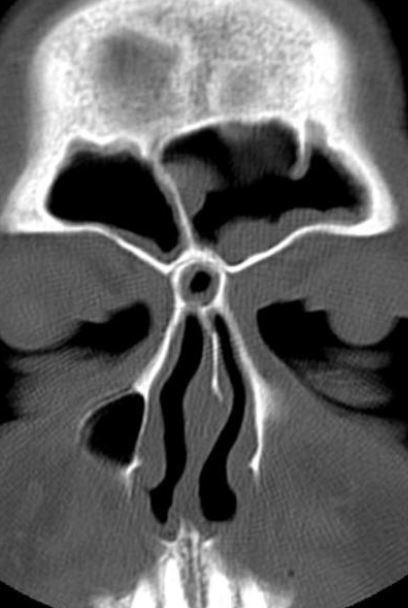Factors in the development of frontal sinusitis
Frontal sinusitis symptoms
Diagnostics
Treatment of acute frontal sinusitis
Symptoms of chronic frontal sinusitis
Diagnostics
Treatment of chronic frontal sinusitis

Factors in the development of frontal sinusitis
The following pathologies contribute to frontitis:
- structural features of the frontal pocket
- curvature of the nasal septum
- hypertrophy of the middle turbinates
The trigger for the onset of frontal sinusitis can be influenza, ARVI, prolonged rhinitis.
Frontal sinusitis symptoms
In frontal disease, patients complain about the following:
- Headache
- Difficulty in nasal breathing
- Purulent nasal discharge
- Soreness in the forehead (frontal sinus projection)
- Inflammation of other sinuses is common
In the absence of timely treatment, the development of various complications (orbital, intracranial, etc.)
If you have these symptoms, urgently consult an ENT doctor.
Diagnostics
If you suspect frontal sinusitis, the doctor conducts a conversation with the patient, finding out all the circumstances of the onset and development of the disease. On examination, changes in the nasal cavity characteristic of sinusitis are revealed: hyperemia of the mucous membrane, discharge from the nose. Endoscopic examination of the nasal cavity is performed.
However, local signs of the disease may be slightly expressed, which makes it necessary to have an X-ray examination - CT of the paranasal sinuses, which gives us a complete picture of the anatomy and condition of the paranasal sinuses at the moment.
Treatment of acute frontal sinusitis
In the treatment of acute frontal sinusitis, the main task is to improve the outflow of pathological discharge from the sinus. To do this, appoint:
- Systemic antibiotic therapy
- Decongestants (vasoconstrictor drops) in the nose for 5 - 7 days
- Anemization of the mucous membrane in the area of the nasolabial pocket is a medical manipulation that allows you to most effectively reduce the swelling of the mucous membrane.
- Mmucolytics and secretolytics are drugs whose action is aimed at liquefying the discharge for the best evacuation.
These activities, as a rule, are enough to stop the process. However, it is important to emphasize that the treatment must necessarily take place under the supervision of a physician. After stopping the process, it is necessary to analyze the causes that led to the onset of acute frontal sinusitis, and conduct surgical treatment in order to eliminate factors predisposing to the disease (correction of the septum, middle shells, etc.).
Rarely, in case of ineffectiveness of conservative therapy, they resort to surgical treatment according to the FESS method or to minimally invasive balloon sinusoplasty. Causes and factors affecting the occurrence of chronic frontal sinusitis
Predisposing factors, as in the case of acute frontal sinusitis, are changes in the anatomy of the nasal cavity or chronic diseases of the nasal cavity and sinuses. Often, chronic frontal sinusitis occurs with improper treatment of acute frontal sinusitis.
Symptoms of chronic frontal sinusitis
With an exacerbation of chronic frontal sinusitis, patients complain of the following:
- Headache (usually in the morning)
- Fast fatiguability
- Swelling of soft tissues in the upper eyelid area
- Dull pain in the eye area
- Difficulty in nasal breathing
- Purulent nasal discharge
Diagnostics
To diagnose the disease, the doctor collects an anamnesis, finding out all the circumstances of the onset and development of the disease, especially for previous cases of frontal sinusitis and methods of its treatment.
The otolaryngologist conducts an examination, endoscopic examination of the nasal cavity and nasopharynx. Clarification of the diagnosis occurs after studying the results of CT. After a complete examination, the optimal treatment tactics are developed.
Treatment of chronic frontal sinusitis
Treatment of chronic frontal sinusitis is possible, as a rule, by surgical methods. Surgical intervention is carried out in order to restore the drainage function of the frontal-nasal pocket. Today, this surgical intervention can be carried out by the endoscopic method, in which the doctor can clearly control the progress of the operation on the monitor, as well as with the help of special instruments that allow manipulation in a narrow space and in conditions of "complex" anatomy.
In order to prevent recurrence of frontal sinusitis, surgical correction of the adjacent intranasal structures is required.
For the treatment of frontal sinusitis, the Acclarent Relieva Ultirra balloon sinusoplasty system has also been developed, which allows minimally invasive expansion of the frontal-nasal pocket and lavage of the frontal sinus in the postoperative period.

